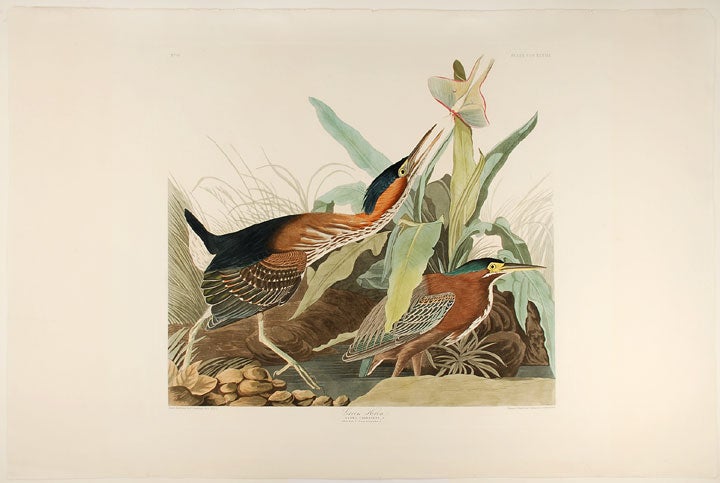AUDUBON, John James (1785-1851)
Green Heron from The Birds of America
[Pl. CCCXXXIII] London: 1836. Hand-colored etching with aquatint and line-engraving by Robert Havell, Jr., after Audubon. Paper watermarked "J. Whatman/1837." Sheet: (24 7/8 x 37 1/4 inches).
The Green Heron from the first edition of Audubon's "The Birds of America."
A finely composed image with a strong upward diagonal movement from the unheeding juvenile bird as it darts its neck out to seize the Luna moth that has momentarily come to rest on the foliage of the marsh plant. Partially concealed under the foliage, an adult bird stalks past more warily. "Pools or bayous, and the margins of the most limpid streams, are alike resorted to by this species for the purpose of procuring food. It is little alarmed by the presence of man, and you may often see it close to houses on the mill-dams, or even raising its brood on the trees of gardens. This is often the case in the suburbs of Charleston, in South Carolina, where I have even seen several nests on the same live oak. The gentleness of this bird is truly remarkable, for it will at times allow you to approach within a few feet paces, looking as unconcernedly upon you as the House Sparrow is wont to do in the streets of London. The Green Herons feed all day long, but, I think, rarely at night. Their food consists of frogs, fishes, snails, tadpoles, water-lizards, crabs, and small quadrupeds, all of which they procure without much exertion. Their gait is light, but firm. During the love-season they exhibit many curious gestures, erecting all the feathers of their neck, swelling their throat, and uttering a rough guttural note like qua, qua, several times repeated by the male as he struts before the female. This note is also usually emitted when they are startled, but when fairly on wing they proceed in silence." [Audubon] "This small dark heron is the most generally distributed member of its family in the United States. At close range it reveals a rich chestnut neck and greenish-yellow or orange legs. In strong light its somewhat iridescent upper-parts may seem more blue than green. Whereas most other herons breed in colonies, the green heron tends to be a loner, usually nesting in the privacy of some thick grove or in an orchard, but there are places, particularly near the coast, where several pairs nest together in loose association." [Peterson] "On the 23d May, 1831, I found two nests of the Green Heron on one of the Florida Keys, close to some of Ardea rufescens and A. coerulea. Now and then a dozen or more of their nests are found on a bunch of vines in the middle of a pond, and placed within two or three feet of the water; while in other cases, they place their tenements on the highest branches of tall cypresses." [Audubon]
Audubon, The Birds of America VI, pp.106-107. Low, A Guide to Audubon's Birds of America, pp.170-171. Peterson, Audubon's Birds of America 31.
Item #4361
Price: $30,000.00


